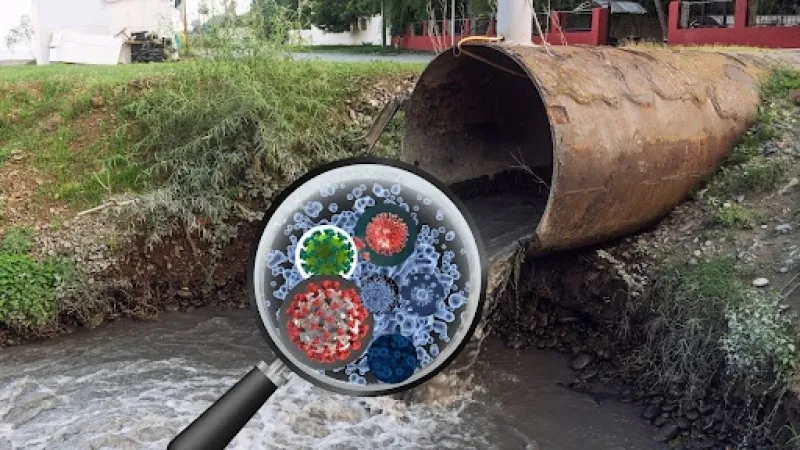
During the early days of the COVID-19 pandemic, every cough and sneeze felt like a potential threat, inviting suspicious gazes from bystanders. Respiratory viruses, ranging from the common cold to the flu and, of course, SARS-CoV-2, often share similar symptoms, making it challenging to distinguish them without specific diagnostic tests. Clinical testing can also become difficult as it relies on individuals getting sick enough to seek medical attention. The stigma associated with COVID-19 also added to the challenge, with individuals refusing to get tested, fearing forced confinement. This challenge underscores a pressing need for more effective methods to track these invisible invaders, particularly in densely populated areas where diseases can spread rapidly.
A new study from Bengaluru has now shown that our city's wastewater holds a surprising amount of information about the health of an entire community. Researchers from the Tata Institute for Genetics and Society, Bengaluru, and Biome Environmental Trust, Bengaluru, show that these sites offer an early warning system for a range of respiratory illnesses.
The researchers embarked on a comprehensive, 28-month journey, collecting over 800 wastewater samples from 28 different sewage treatment plants (STPs) across the city, which serves approximately 11 million people. Their goal was to determine if wastewater surveillance, a method that has proven invaluable for tracking SARS-CoV-2, could also be used to monitor other common respiratory viruses, such as influenza A (IAV), influenza B (IBV), and respiratory syncytial virus (RSV).
Did you know, environmental surveillance of poliovirus in India played a crucial role in the country's polio eradication efforts in 2012? |
The team began by collecting monthly grab samples of raw wastewater from the influent of the STPs. These samples were then carefully processed to pull out the viral particles. Next, the genetic material or RNA from the viruses was extracted. To identify and quantify the viruses, the researchers used the well-known Reverse Transcriptase-quantitative PCR (RT-qPCR). The method allows researchers to amplify the number of specific viral genetic sequences, allowing them to determine the viral load.
They also identify the genetic makeup of the viral strains using DNA sequencing technologies. For influenza, they used metagenomic shotgun sequencing to identify different influenza subtypes in the sewage. For SARS-CoV-2, they used targeted sequencing to identify specific variants. Computer algorithms then analysed these genetic sequences to determine the relative abundance of various influenza subtypes and SARS-CoV-2 variants over time. This detailed genetic analysis allowed them to track the evolution of the viruses and understand which strains were dominant at different periods.
The study showed that wastewater could provide a dynamic diary of viral activity, showing the type of virus and its numbers. They found SARS-CoV-2 in a remarkable 86% of samples, indicating its widespread presence throughout the study period. While influenza and RSV were less prevalent, they still showed up consistently, with IAV in 37% of samples, IBV in 16%, and RSV in 15%.
The study also revealed clear seasonal patterns for influenza viruses, with a noticeable increase during the monsoon season and peaks in October each year. For instance, the mean viral load for IAV was around 755 copies per person per day in 2021, surged to 2000 in 2022, and remained high at 1749 in 2023. IBV followed a similar trend, also peaking in October, while RSV had a shorter transmission window, peaking around the same time. Interestingly, while SARS-CoV-2 was constantly evolving with new variants, like BA.2.10, BA.2.X, XBB, and JN.1, driving its surges, these peaks generally didn't overlap with those of influenza and RSV, except for the XBB surge in 2023, which coincided with IAV and IBV activity. This suggests that different viruses have their own distinct seasons or transmission dynamics. The researchers also identified a diverse range of influenza A subtypes, including H1N1, H3N2, and even avian-like strains such as H4N8 and H9N5, highlighting the potential for wastewater to detect viruses that might jump from animals to humans.
This research demonstrates that wastewater surveillance can effectively monitor a range of respiratory viruses, not just SARS-CoV-2. While earlier studies correlated influenza positivity in wastewater with clinical cases, the new study offers a more comprehensive understanding of viral diversity at the community level, particularly in settings where clinical testing may be limited. The unbiased nature of metagenomic sequencing means they could detect a wider array of pathogens than traditional targeted tests.
However, the study also acknowledged that monthly sampling, while effective for seasonal trends, might miss rapid changes that weekly sampling could catch. Additionally, some of the bioinformatics pipelines used for influenza subtype assignment were quite conservative, which may have led to the overlooking of some minority strains. The researchers suggest that future work could benefit from more modern whole-genome sequencing approaches to get even better coverage of the segmented influenza genome.
By continuously monitoring wastewater, cities like Bengaluru can establish an early warning system for respiratory virus outbreaks, understand their seasonal patterns, and track the emergence of new variants. The information is crucial for making informed decisions about vaccination campaigns, testing priorities, and public health interventions. In a world where new infectious diseases are a constant threat, knowing what's circulating in our communities, even before people get sick, could be an invaluable tool for protecting us all.
This article was written with the help of generative AI and edited by an editor at Research Matters.





